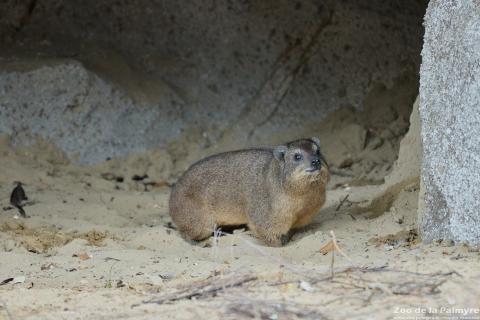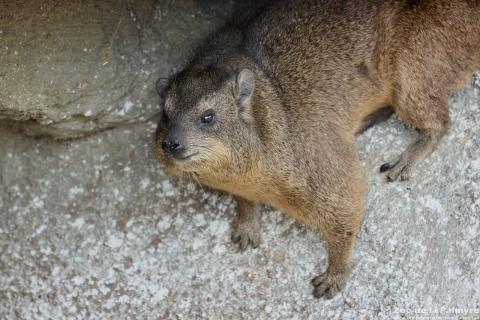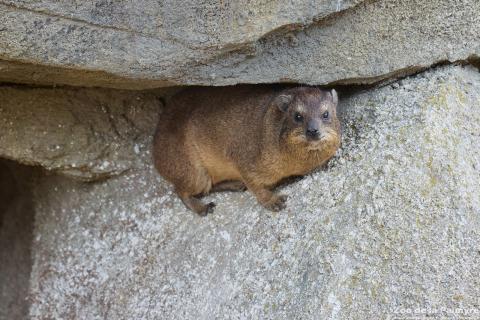Rock hyrax

Rock hyrax

-
Class
Mammalia -
Order
Hyracoidea -
Familly
Procavidae
-
 40-55cm
40-55cm -
 1.8-5.4kg
1.8-5.4kg -
 6-8 months
6-8 months -
 1-4
1-4 -
 12 years
12 years
-
Diet
herbivorous (leaves, twigs, bark, fruits) -
Habitat
rocky areas -
Range
Sub-Saharan and Southern Africa, Arabian Peninsula -
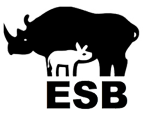 This species is part of a European Breeding Program
This species is part of a European Breeding Program
-
Population in the wild
Stable -
IUCN REDLIST status

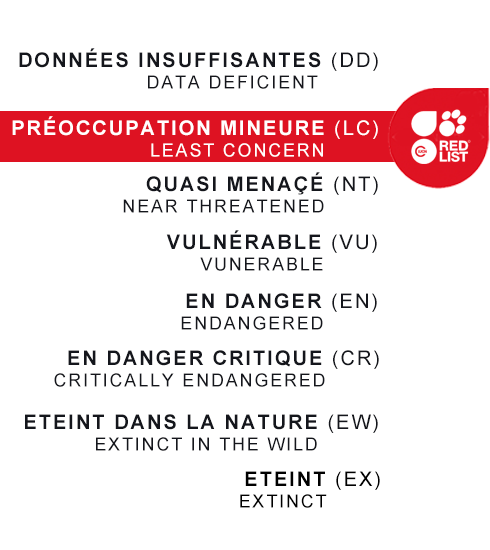
17 subspecies of Rock hyrax have been recognized but several species probably exist. There is extensive variation in coat color which varies widely throughout their range from a yellowish-buff to a dark brown.
Rock Hyraxes are the largest living member of the Procavidae family. They are agile climbers and jumpers. They have long vibrissae on the face and other widely distributed over their bodies, probably for orientation in dark fissures and holes that provide suitable shelters. Sweat glands keep the soles of their feet always moistened, thus increasing their grip on the rocks. They also have a dorsal gland secreting pheromones which are likely used to mark their territory and help young imprint on their mother when they climb onto her back.
Their diet include a variety of grasses, forbs, buds, fruits and berries. In the Serengeti, rock Hyraxes were observed feeding on 79 plant species! Most feeding occurs during morning and afternoon. The rest of the day is spent basking to maintain their body temperature and resting to conserve energy. During the dry season, when the grass withers, Rock Hyraxes eat more leaves climbing on shrubs.
Rock Hyraxes live in family groups numbering as many as 80 individuals and and consisting of one adult territorial male, several related adult females, subadults and juveniles of both sexes. The size of the group depends on that of the « kopje » (afrikaans word designating a small rocky hill in the African savannah) on which it lives. During the breeding season, territorial males can be very aggressive towards other males.
Gestation is 212-240 days, which is exceptionally long for such a small mammal. It may represent a primitive characteristic, given the much larger body sizes of the ancestral hyrax species. The rock hyrax is likely a close relative of… the elephant! Just like him, it has large molars allowing it to crush tough plants, prominent upper incisors in the shape of tusks or even fingers equipped with flat nails like ungulates.
Young usually weigh 195g. They are capable of agile movements within a few hours and can ingest solid food within a few weeks. They reach sexual maturity at about 16-17 months and the males leave their group before the age of 2.5 years.
The main predators of Rock Hyraxes are birds of prey (Verreaux eagle, crowned hawk-eagle), big cats (leopards, lions, caracals), hyenas and snakes.
Although it is sometimes hunted, the species is widespread on the African continent and found in many protected areas. It is therefore not classified as an endangered species.

